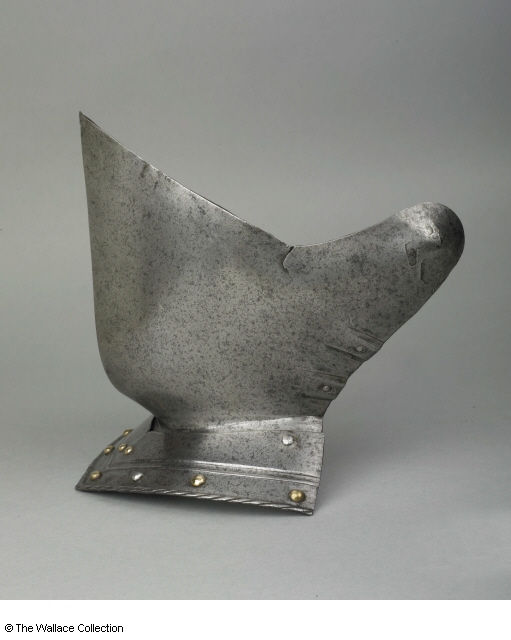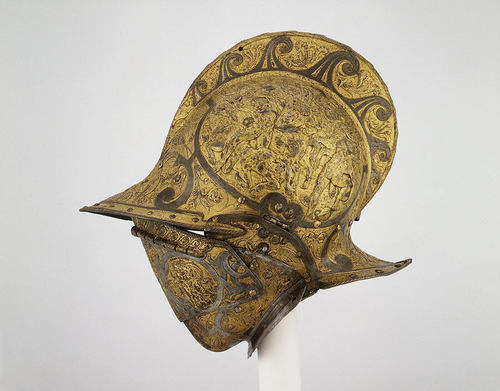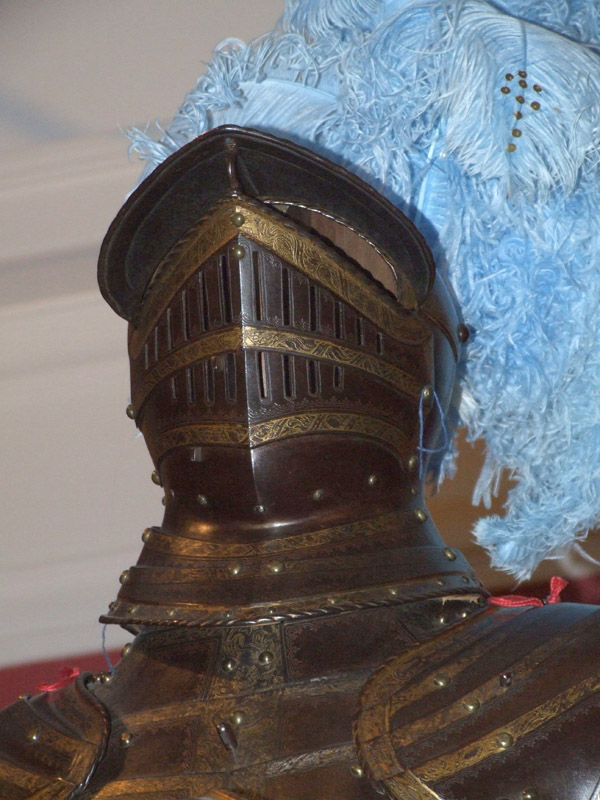I'm curious as to two of the elements shown in this drawing of a Greenwich garniture from the Jacobe Album:
1. The item in the upper left, beneath the helmet and to the left of the reinforcing breastplate. It looks like a bevor in profile. As in, the type of bevor that was worn with a sallet. Is that what it is? Why is it in this garniture? Wouldn't such an item be very outdated in the late 1500s?
2. The two items above the shaffron and below the gauntlets. Are these spare tassets? How are these tassets different from the regular ones on the armour at left, and why would they be included in the garniture?
Many thanks to anyone who knows.
[ Linked Image ]
Another picture showing similar things:
[ Linked Image ]
The first is similar to a bevor but in this period is called a falling buffe. Used for light cavalry and heavy infantry work, where you need to switch between fully enclosed face and unenclosed face quickly and easily.
Your second is correct again. They are longer than the tassets currently attached in the complete harness picture. They would increase the overlap between the tassets and the leg armour, and possibly could be worn without leg armour when fighting at a barrier.
I love these pictures of garnatures. I've got quite a few from the V&A in London. Very nice stuff.
Your second is correct again. They are longer than the tassets currently attached in the complete harness picture. They would increase the overlap between the tassets and the leg armour, and possibly could be worn without leg armour when fighting at a barrier.
I love these pictures of garnatures. I've got quite a few from the V&A in London. Very nice stuff.
Yeah, I know about the falling buffe; it was worn with a burgonet. Many falling buffes are shown in the Greenwich drawings. But how do you explain this then? Clearly the falling buffe can be seen, next to the burgonet - and then there's the other thing, too, right underneath it. They're clearly shown as different items with different shapes.
[ Linked Image ]
[ Linked Image ]
Well, for item #1 my first guess would be that it's a wrapper. A reinforcing piece added specifically for the joust. It would add an extra layer over the face and be solid on the left side to protect against lances. The last picture you show makes me less sure. However, same piece on the last picture could still be a wrapper. It looks to me like it's taller than the buffe for the burgonet and smoother i.e. better for a lance hit.
For item #2 the idea of longer tassets for combat at the barriers sounds good to me. Do you think that they'd attach at the bottom of the regular tassets?
Cheers,
Steven
For item #2 the idea of longer tassets for combat at the barriers sounds good to me. Do you think that they'd attach at the bottom of the regular tassets?
Cheers,
Steven
I'd also vote for "wrapper"
 Attachment: 90.73 KB
Attachment: 90.73 KB


Could it be that the second buffe/bevor allows the burgonet to fulfill the role and look of a closed helm.
mackenzie
----------------------------------------------------------------------
 Attachment: 34.82 KB
Attachment: 34.82 KB

Burgonet with Falling Buffe, ca. 1555
French (Paris)
Steel, blued and gilded; H. 14 in. (35.5 cm), Wt. 5 lb. 6 oz. (2.4 kg)
mackenzie
| Adam D. Kent-Isaac wrote: |
| Yeah, I know about the falling buffe; it was worn with a burgonet. Many falling buffes are shown in the Greenwich drawings. But how do you explain this then? Clearly the falling buffe can be seen, next to the burgonet - and then there's the other thing, too, right underneath it. They're clearly shown as different items with different shapes.
[ Linked Image ] |
----------------------------------------------------------------------

Burgonet with Falling Buffe, ca. 1555
French (Paris)
Steel, blued and gilded; H. 14 in. (35.5 cm), Wt. 5 lb. 6 oz. (2.4 kg)
#1 is most likely the falling buffe, if there's horizontal lines drawn on it, and otherwise, is likely a wrapper of closely associated shape.
here's the pembroke harness with it, which has all its exchange peices surviving.
(please excuse the misnamed file, I'd named it that for somone else to identify it :) )
I'll try to get photos of the other bits resized to fit on the forum tomorrow, as I'm about to go sleep.
 Attachment: 156.63 KB
Attachment: 156.63 KB

here's the pembroke harness with it, which has all its exchange peices surviving.
(please excuse the misnamed file, I'd named it that for somone else to identify it :) )
I'll try to get photos of the other bits resized to fit on the forum tomorrow, as I'm about to go sleep.

I didn't know they used wrappers at that point; I thought the grandguard would fulfill the duty of a wrapper - but maybe the wrapper was used for foot combat.
Some garnitures consisted of burgonets with more than one buffe. These garnitures were meant to have everything you needed for harnesses for combinations of the following:
Jousting
Foot combat
Foot combat at the barrier
Mounted heavy battlefield combat
Light cavalry
Infantry
Some garnitures had a field close helm, tilt close helm, and burgonet, with wrappers/buffes, etc.
I think those wedges either are designed to show the buffes from another angle (similar to a cross-section view) or they could be bolt-on brow/visor reinforcements or something.
What period of Greenwich armour do those images date from? Early on, Greenwich armours tended to have rounded shapes to the front of helms. Later on, they went to the sharp prow-like forward projection. It's possible those wedge shapes were designed to show the forward-projecting shape of that newer style.
But I'm just guessing. :)
Jousting
Foot combat
Foot combat at the barrier
Mounted heavy battlefield combat
Light cavalry
Infantry
Some garnitures had a field close helm, tilt close helm, and burgonet, with wrappers/buffes, etc.
I think those wedges either are designed to show the buffes from another angle (similar to a cross-section view) or they could be bolt-on brow/visor reinforcements or something.
What period of Greenwich armour do those images date from? Early on, Greenwich armours tended to have rounded shapes to the front of helms. Later on, they went to the sharp prow-like forward projection. It's possible those wedge shapes were designed to show the forward-projecting shape of that newer style.
But I'm just guessing. :)
The wrapper/buffe looks so huge that it wouldn't even fit with the burgonet; the top of it would be pushing up against the helmet's peak. Unless it's deliberately drawn larger relative to the burgonet.
| Adam D. Kent-Isaac wrote: |
| The wrapper/buffe looks so huge that it wouldn't even fit with the burgonet; the top of it would be pushing up against the helmet's peak. Unless it's deliberately drawn larger relative to the burgonet. |
That assumes that the whole drawing is to a consistent scale, which I don't believe it is. :)
| Adam D. Kent-Isaac wrote: |
| I didn't know they used wrappers at that point; I thought the grandguard would fulfill the duty of a wrapper - but maybe the wrapper was used for foot combat. |
[speculation] If these drawings are meant to be catalogue images then they could simply represent all possible accessories. Not everyone buys every accessory. There is personal preference involved. But they could get whatever they want. [/speculation]
If it were a modern catalogue I'd have no doubt. But I don't know what the norm was for this era.
Cheers,
Steven
Page 1 of 1
You cannot post new topics in this forumYou cannot reply to topics in this forum
You cannot edit your posts in this forum
You cannot delete your posts in this forum
You cannot vote in polls in this forum
You cannot attach files in this forum
You can download files in this forum
All contents © Copyright 2003-2006 myArmoury.com — All rights reserved
Discussion forums powered by phpBB © The phpBB Group
Switch to the Full-featured Version of the forum
Discussion forums powered by phpBB © The phpBB Group
Switch to the Full-featured Version of the forum